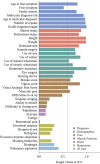Convergence of patient- and physician-reported outcomes in the French National Registry of Facioscapulohumeral Dystrophy
- PMID: 35236385
- PMCID: PMC8890461
- DOI: 10.1186/s13023-021-01793-6
Convergence of patient- and physician-reported outcomes in the French National Registry of Facioscapulohumeral Dystrophy
Abstract
Background: Facioscapulohumeral muscular dystrophy (FSHD) is among the most prevalent muscular dystrophies and currently has no treatment. Clinical and genetic heterogeneity are the main challenges to a full comprehension of the physiopathological mechanism. Improving our knowledge of FSHD is crucial to the development of future therapeutic trials and standards of care. National FSHD registries have been set up to this end. The French National Registry of FSHD combines a clinical evaluation form (CEF) and a self-report questionnaire (SRQ), filled out by a physician with expertise in neuromuscular dystrophies and by the patient, respectively. Aside from favoring recruitment, our strategy was devised to improve data quality. Indeed, the pairwise comparison of data from 281 patients for 39 items allowed for evaluating data accuracy. Kappa or intra-class coefficient (ICC) values were calculated to determine the correlation between answers provided in both the CEF and SRQ.
Results: Patients and physicians agreed on a majority of questions common to the SRQ and CEF (24 out of 39). Demographic, diagnosis- and care-related questions were generally answered consistently by the patient and the medical practitioner (kappa or ICC values of most items in these groups were greater than 0.8). Muscle function-related items, i.e. FSHD-specific signs, showed an overall medium to poor correlation between data provided in the two forms; the distribution of agreements in this section was markedly spread out and ranged from poor to good. In particular, there was very little agreement regarding the assessment of facial motricity and the presence of a winged scapula. However, patients and physicians agreed very well on the Vignos and Brooke scores. The report of symptoms not specific to FSHD showed general poor consistency.
Conclusions: Patient and physician answers are largely concordant when addressing quantitative and objective items. Consequently, we updated collection forms by relying more on patient-reported data where appropriate. We hope the revised forms will reduce data collection time while ensuring the same quality standard. With the advent of artificial intelligence and automated decision-making, high-quality and reliable data are critical to develop top-performing algorithms to improve diagnosis, care, and evaluate the efficiency of upcoming treatments.
© 2022. The Author(s).
Conflict of interest statement
The authors declare that they have no competing interests.
Figures


References
-
- Kinoshita J. Dogs destined to develop muscular dystrophy evade their genetic fate. FSH Society website. Published November 17, 2015. https://www.fshsociety.org/2015/11/dogs-destined-to-develop-muscular-dys.... Accessed 15 Jan 2019.
Publication types
MeSH terms
LinkOut - more resources
Full Text Sources

